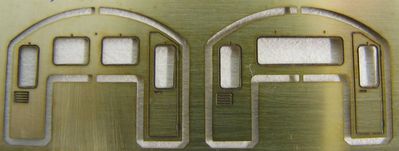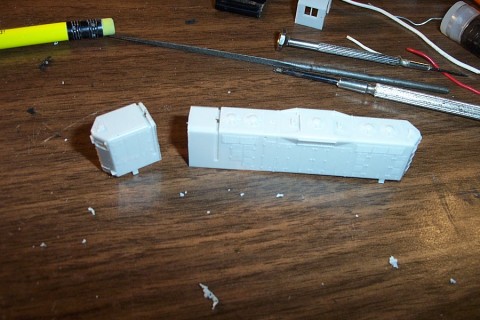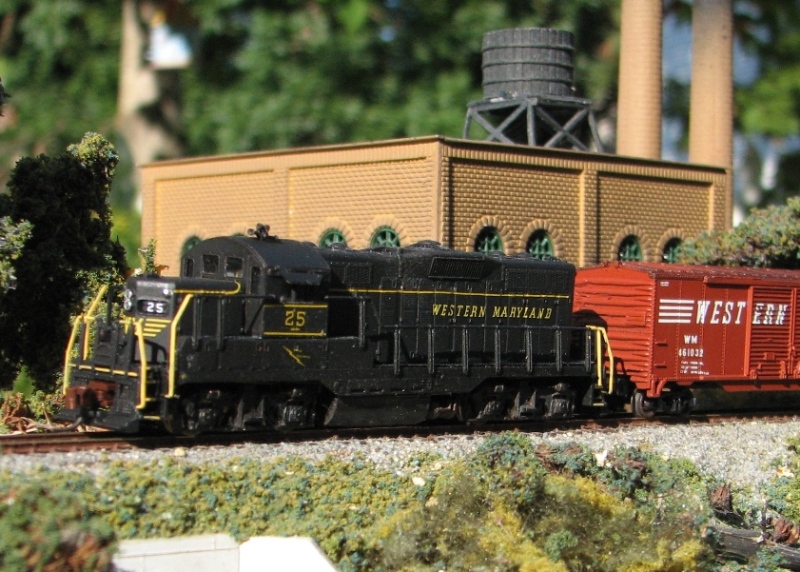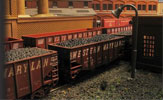
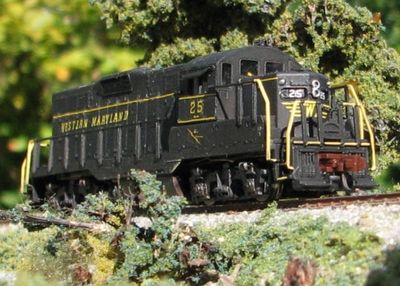
Modifying the Life Like GP-20 Drive
I selected the Life Like drive for this project because it already provided for a low short hood. It turned out I still needed to mill the front down to make room for the WM's nose-mounted number boards and headlight.
The GP-20, like most older LifeLike (pre-Walthers) frames, is not inherently friendly to DCC. I had to cut channels for the various lead wires from the decoder to the pick-ups, and to the motor contacts. I also had to mill about 3/32" from the top of the frame to make room for the wires and connections under the shell, and about 3/16" from the rear to make room for the chip and a rear light.
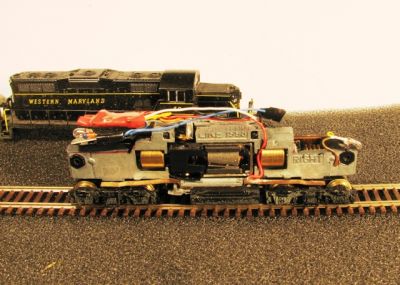
The chip I installed is a Digitrax DZ123. A newer DZ-125 is smaller, and would require less milling of the frame. On this one, the forward light function got zapped, so I hardwired a 15v grain of wheat bulb to the frame using the mounting screws.
The amount of material you need to remove is substantial, and it does diminish the weight of the unit. I also experience more noise from the drive than I did before it was modified. They work fine for switching, or in m.u. with other engines, but on future Geeps, I plan to use the new Atlas GP-7/9 drive, which allows for a drop in decoder, and only requires a small amount of milling for the nose headlight.
The Finished Product
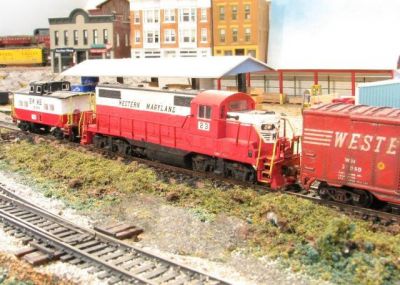
GP-7 23 in Red White and Black "Circus". Decals are from an old Northeast Decals set. Microscale decals do not offer the correct sized lettering in black. I'm working on making these available again.
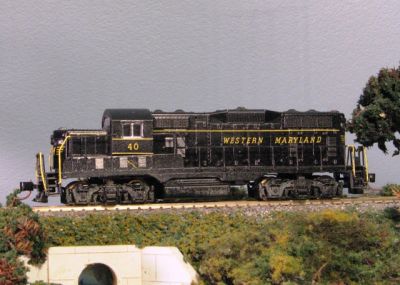
GP-9 #40 in speedlettering. In 1969, 40 received the unique red Scotchlite logo on it's nose in an attempt to improve the visibility of trains at grade crossings. The company decided to adopt the red white and black "circus" colors instead, and the experiment wasn't applied to any other engines. Microscale does include appropriately sized lettering, as well as the red nose herald to model this engine accurately.
History
Beginning in 1962, the Western Maryland undertook a project to improve the visibility from the cab of its fleet of GP 7's and 9's. The modifications were done in the company shops at Hagerstown, creating the well-known "chop-nose geeps" that were a familiar site all over the WM system. All of these geeps were first painted in the black with gold "speed" lettering, and many were repainted after 1969 into the new Red White and Black "circus" scheme, including Roster
The Western Maryland GP-7's were #20-24, and were recognizable for their lack of dynamic brakes, so there's no "blister" midway down the top of the long hood. GP-7 #23 was the last engine to be chopped in 1969, and among the first to receive the red white and black "circus" paint scheme.
GP-9's were numbered 25-45. Engines 27, 28, 29, 32, 35, 38, 39, 42, and 43 were eventually painted into the circus scheme. GP-9 #25 was the first to receive the modified short hood, and is unique as the only one to have a dual windshield. All the other Hagerstown Choppers had the large, single pane windshield. In 1974 it was renumbered to 6400 by the Chessie System, and by 1978 it had been painted in Chessie's yellow, blue and vermillion. It was sold in the early 1990's to a shortline in Georgia, which retained the Chessie paint scheme, and in 2008, it was purchased by the George's Creek Railroad, which operates former WM trackage around Westernport, Maryland. The GCRR has beautifully restored this historic locomotive to it's 1962 appearance in stately black speedlettering.
You can find more information and prototype photos of the different paint schemes at the Northeast Railfans' WM Roster Site. Currently, the N Scale Western Maryland rosters three of these beasties, GP-7 #23, and GP-9s #25 and #39. GP-9 #40, illustrated here, was an early attempt that didn't use the brass cab face, and I sold it in 2009. Our goal is to add 4 to 6 more of these locomotives and assign them to a variety of jobs, just as the prototype did.
Modifying the Atlas Shell
The models of 23 and 40 are hybrids, combining customized Atlas GP shells with the drives from Life Like GP-20's. Future models will be constructed using the new Atlas DCC-friendly GP-9 drive. I also jerry-rigged the windshields using the glazing from the GP-20. I have since had etched brass cab fronts made (available from Mill Street Studios) which I used on #25.
I separated the stock cab from the main car-body, and used 150 grit sandpaper to carefully remove the details from the front face of the cab. You also want to cut the little tab at the top of the front opening so it doesn't obstruct the new windshield frame. I installed the new cab face with some CA super glue. Make sure you have it aligned properly at the roof line, and everything else should fall into place. Click on the thumbnails below for a more detailed view of each step.
Next, I used and X-acto fine tooth razor saw to cut the short hood away from the shell, making the cut just behind the groove that holds the front of the cab in place.
Using the cab as a guide, I inserted the short hood, and marked a line at the point where the bottom of it would be cut away, lowering the top of the short hood down to clear the new windshield. I then used the razor saw to make the cut, a little bigger than the finished size so I could sand it down to a more precise fit. You can insert a small block of wood or other scrap to keep the nose steady while you're cutting.
Next, I inserted some styrene shims to fill the space left by the saw cut, and re-glued the shell together with some thin pieces of styrene to reinforce the joint. The reinforcement has to stay above the level of the cab bottom, or it will interfere with the walkway when you re-assemble everything.
I test fitted the assembled shell over the modified frame, then got it ready to paint. Before painting, I added some WM-specific details, including sun shades from Gold Medal Models, and an Atlas 5-Chime Horn (part no. 544509). The brass cab face has drilling dimples for the installation of windshield wipers by BLMA or Gold Medal if you're so inclined. I'll be adding those later.
#25 rides on an Atlas Classic GP-9 frame (circa 1995) and is hardwired with a Digitrax DZ-125 Decoder. It was painted with gloss black paint, lettered with Micro Scale decals, and sealed with Testor's Dullcoat.
